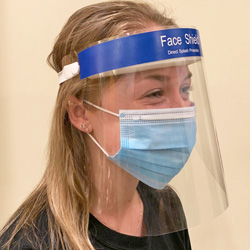Greetings All,
Although the Hazcom/GHS standard does not apply to students, I think there
is some room for 'thinking outside the box' so that we can meet the intent
of the standard and, thus, provide effective, safe communication to
students.
First:
From (c) Definitions: "Label elements" means the specified
pictogram, hazard statement, signal word and precautionary statement for
each hazard class and category."
Second:
From (f)(6) Workplace Labeling: "Except as provided in paragraphs
(f)(7) and (f)(8) of this section, the employer shall ensure that each
container of hazardous chemicals in the workplace is labeled, tagged or
marked with either: ...
(ii) Product identifier and words, pictures, symbols, or combination
thereof, which provide at least general information regarding the hazards
of the chemicals, and which, in conjunction with the other information
immediately available to employees under the hazard communication program,
will provide employees with the specific information regarding the
physical and health hazards of the hazardous chemical."
Third:
From (f)(7): "(f)(7) The employer may use signs, placards,
process sheets, batch tickets, operating procedures, or other such written
materials in lieu of affixing labels to individual stationary process
containers,..."
So, a combination of identifying small containers with at least the name
of the material plus a number or color coded designation that is tied to a
poster/legend/handout that then provides the required labeling elements
for that material (and any other materials requiring the same elements)
may be the most practical and effective. Although the standard refers to
using batch tickets, etc. for stationary containers, and not very small
containers, I think for our identified need this type of approach is worth
considering.
We shouldn't miss the opportunity of integrating the hazardous
identification/communication piece into the lab session curriculum such
that students have to actively access and understand the information, as
confirmed by the lab write up or quizzes, etc.
Also, smart phone access of QR squares, label scans, etc,. that can bring
chemical hazard information to the user/student might be considered as
well.
Best,
Kevin
Kevin Creed
Manager, ChemTracker Program
Stanford University
EH&S
480 Oak Road
Stanford, CA 94305-8007
office: 650-723-4767
cell: 408-529-0724
-----Original Message-----
From: DCHAS-L Discussion List [mailto:dchas-l**At_Symbol_Here**MED.CORNELL.EDU] On Behalf
Of Osterby, Meg
Sent: Sunday, November 17, 2013 8:18 AM
To: DCHAS-L**At_Symbol_Here**MED.CORNELL.EDU
Subject: Re: [DCHAS-L] GHS and secondary container labeling in acedemia
I also need a solution to this issue. We are a small technical college
and have less than 100 total lab students spread between 3-5 courses each
semester. We use 60 mL droppers for most lab solutions, since larger
amounts are far more than we would use in years. Even so, our dropper
bottles are used multiple semesters. We store them in wooden sleeves on
shelves in the stockroom. In the past, we've labeled them with the
chemical name or formula and concentration only, since they are so small
there isn't room for much more. How do we deal with the new labeling
requirements when there isn't physically room on the bottle for such a
detailed label? Would putting the labels on the wooden sleeves be
sufficient? (They don't go into the lab with the solutions, however, so
the students using the solutions would never see them.) I don't see a
solution to this dilemma, since the bottle sizes are so small.
Meg Osterby
Lead Chemistry Instructor
Western Technical College
400 7th St. N.
LaCrosse, WI 54601
osterbym**At_Symbol_Here**westerntc.edu
608-789-4714
"It's better to be careful 100 times, than to be killed once."
Mark Twain
-----Original Message-----
From: DCHAS-L Discussion List [mailto:dchas-l**At_Symbol_Here**MED.CORNELL.EDU] On Behalf
Of Marlyn Newhouse
Sent: Sunday, November 17, 2013 8:37 AM
To: DCHAS-L**At_Symbol_Here**MED.CORNELL.EDU
Subject: Re: [DCHAS-L] GHS and secondary container labeling in acedemia
Dear Ones,
We stopped using the smaller bottles and are using 100 mL bottles. We
attach a test tube with a small pipette for the "dropper". The label and
test tube are secured with clear packing tape.
Blessings
Marlyn Newhouse, D.A.
Associate Professor of Chemistry
1050 Union University Drive
Jackson TN 38305
731-661-5295
mnewhous**At_Symbol_Here**uu.edu
>
________________________________________
From: DCHAS-L Discussion List [dchas-l**At_Symbol_Here**MED.CORNELL.EDU] On Behalf Of
Melissa Charlton-Smith [charltonsmith**At_Symbol_Here**WVWC.EDU]
Sent: Sunday, November 17, 2013 7:42 AM
To: DCHAS-L**At_Symbol_Here**MED.CORNELL.EDU
Subject: [DCHAS-L] GHS and secondary container labeling in acedemia
Out of curiosity, for those of you in academia, how are you handling GHS
secondary container labeling in teaching lab situations where the average
freshman student isn't exactly known for their attention to detail? We
often have a multitude of small dropping bottles with 30 to 50 ml which
becomes a labeling nightmare because of lack of space for labels due to
the small size of the container.
Mel
Mel Charlton-Smith
School of Sciences Chemical Hygiene Officer-NRCC Lab Coordinator, Lecturer
BS-CHO program Department of Chemistry WV Wesleyan College Buckhannon, WV
26201
charltonsmith**At_Symbol_Here**wvwc.edu<mailto:charltonsmith**At_Symbol_Here**wvwc.edu>
304-473-8355
